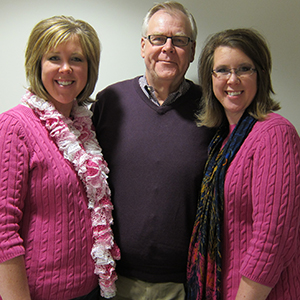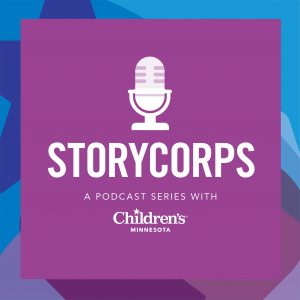Hemophilia: Katie, Kristie and John’s story


About this episode
Twins Katie and Kristie discuss their family history of Von Willebrand’s Disease with their father, John. Katie and Kristie were diagnosed later in life, allowing for their complex family history to be explained. This diagnosis has both strengthened their family bond, and also provided a lesson in advocacy for each family member.
Topics:
- Diagnosis: Unknown family history
- Resilience: Future
- Support: Family
- Treatment: Advice/ Messages
Transcript
John: One of the early stories that I remember hearing about concerned my father’s sister, Sidney. Sidney actually bled to death around 1910 just before my father was born. She was 13 or 14 at the time. The family was poor, as I mentioned, so they had no money to call a doctor or a hospital, so the family reached out to a name that I’ve heard called Lars the Finlander, who apparently was a local healer, but unfortunately, he was unable to stop the bleeding and she passed away. My father, Harold, who was born in 1911, was the last of 8 children. My father actually lost all of his teeth prior to attending high school. He had a tendency to bruise very easily, and he was definitely not a hemophiliac, but [he] did have difficulty stopping any bleeding once it started. I remember that his doctor at the time prescribed large amounts of vitamin K as a supplement to help slow the bleeding. Prior to my father purchasing his first electric razor, his face was always bloodied every time he shaved with a razor.
Katie: How did you know that he definitely was not a hemophiliac?
John: Well, I think in the case of hemophilia, the bleeding doesn’t stop. Ultimately, his bleeding did stop if it was put under pressure. One of the early stories that I remember hearing about was when I had my tonsils removed, which was some time in 1951 or maybe early 1952. Obviously, I don’t remember the event, but my mother always spoke of almost losing me after surgery due to excessive bleeding. As a child in grade school and junior high school, I remember having sore knees and ankles, not all of the time, but on occasion. In those days, a typical response to a complaint like that was to just toughen up, so I think I limped a lot.
Katie: But your mom was a nurse, right? I wonder how she helped you deal with these sore joints.
John: Well, my mother’s response was to put hot, wet towels on my knees and ankles. I believe in the day they called it a hot pack. I do not ever remember using cold to treat anything, so in retrospect, if the pain was caused by a joint bleed, hot packs may have made the problem worse. By the time I got to high school, I was involved in sports and particularly enjoyed football, so I did play high school football. Shortly after the season started, I was always black, blue, purple, orange, and yellow from my shoulder pads down to my fingernails.
Katie: Did anybody ever question you about these bruises?
John: Surprisingly, no. Nobody ever questioned the bruising. . It turned out that my hemoglobin was very low due to a perceived internal bleeding. I ended up in intensive care for a week where they diligently looked for an ulcer that they suspected was the source of the bleeding. As a side note, at the time I was unable to take ibuprofen due to the kidney disease, and Tylenol was not effective, so when I needed a pain reliever I used 1,000 milligrams of aspirin—something a person with a bleeding disorder should never use, but I’d still never heard the term von Willebrand’s disease.
Katie: On July 6th, 2005, I gave birth to my first child, and I remember losing a large amount of blood during the delivery, and when I noticed this amount of blood, I quickly recalled from my childhood the fact that I bled a lot with bruises, and we always grew up thinking that we had thin blood. So I decided to ask my nurse if this was normal to see this much blood, and she quickly reassured me that everything’s fine, this is very normal, there’s nothing to worry about. And I went on and think much more of the situation. Shortly after my son was born on July 6th, we discovered that he had a brachial cleft cyst in his neck, and we decided that we would like to remove this cyst, and during the pre-op physical the physician asked me about our family history. Of course, I had told her the same thing that I’ve always told every doctor about my great-aunt who bled to death when she was at a young age. Nobody ever stopped me with this comment, but Adam’s pediatrician did. She stopped our conversation immediately and she informed us that von Willebrand’s disease is hereditary, and it either had to have come from Adam’s mom, myself, or Adam’s father. And one of us had to pass it on to him. Clearly, every answer pointed to me based on that testing. But at the time, my test results showed much different numbers than SON’s for factor VIII and von Willebrand’s factor. We took the test results that were on the paper that we both have type 1, and we never questioned it.
Things were pretty normal for our family between 2009 and 2011, when my daughter was born. Shortly after her birth we hosted Thanksgiving at our house in November, 2011. I remember she got a very significant nose bleed, and my mom was holding her, and she had blood dripping down her face, lots of blood clots coming out. This scared me to see this in such a young child, so almost immediately I knew she probably had von Willebrand. So we brought her in shortly after about three months of age, and they drew blood from her, and immediately I knew something was different, because when they drew the blood, they had to hold her arm down. Shortly after that blood draw, our hematologist called and told us that her factor VIII was only one percent and that this was very odd. So we brought her back in and had her blood drawn again, and they called us back and said unfortunately, her result is the same, she has a one percent factor VIII, and we can’t really explain this because it does not correlate at all to Mom’s numbers or brother’s numbers. So the hematologist whom we respected very much at the time said that there were two reasons this could’ve happened, and one was a spontaneous mutation of the gene causing her to have a type 3 von Willebrand’s versus what we were diagnosed with, which was a type 1, or there was a potential that Dad could have it. We decided we should get him tested regardless, so my husband got tested, and his test results were borderline type 1. We were surprised at his result. I had no idea I had married somebody who was borderline type 1 von Willebrand’s.
Kristie: What advice or lessons learned do we all have to share about the von Willebrand’s diagnosis?
John: Well, I guess for me, number one is we have to be our own advocates. If something seems strange, or wrong, or you’re questioning it, just keep asking until you know that you’ve got the answer that makes sense to you. Also remember that internal bleeds are serious. No longer are we telling people to just toughen up. It needs to be addressed and perhaps treatment needs to be sought out.
Katie: Great. I completely agree with you about what you said about being an advocate for yourself and others. Always request that hematology be involved in your care. I also think going to a hemophiliac treatment center, which they call an HTC, is very valuable. I did not do this at first for my own health, we were not at an HTC with Marnie at the UNIVERSITY HOSPITAL, and we were encouraged to bring her to Children’s, and that has been a life-saving measure for us
Kristie: My advice is that we really need to teach our children to know what the disorder is and how to get help, especially if they’re away from family. I also think it’s very important to listen to your gut. There are a lot of times that someone will be injured, or something’s going on, and you’re scared, and you’re not sure if you need to worry about the bleeding or not. You just really need to listen to yourself and call the HTC to check it out or get a second opinion on whatever it is that caused the worry to begin with.
Katie: Lastly, just learning to deal with not letting this disorder define you, that there’s so much about all that we have to offer, and von Willebrand’s is just something we deal with on the side and manage, but life still goes on, and it’s not something that you should think of first when you think about yourself or describe yourself to others.
We wish to extend our thanks to the families who have shared their story here about the impact of living with hemophilia and sickle cell disease. We would also like to thank the many who worked on this project:
The Children’s Minnesota StoryCorps Legacy Team:
Eddie Gonzalez, Jocelyn Bessette Gorlin, Susan Kearney, Stephen Nelson, Margaret Heisel-Kurth, Stephanie Davis, Angela Blue, Elizabeth McDonough, Jill Swenson and Alisa Linne.
Special thanks to:
Stephanie Moua, Hamdi Hussein, Sadia Farah, Fatima Ali, Caillyn Costello, Suzanne Lehman, Suzan Ulrich, D'Ann Urbaniak Lesch, Justin Nelson, Allison Albright, Marvin Holmes-Leopold, Jose Rodriguez and Mitch Hare.
Minneapolis Institute for Production and Recording:
Jose Rodriguez and Mitch Hare.